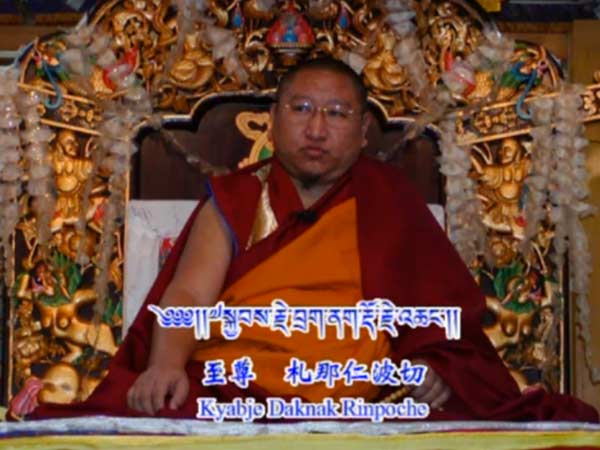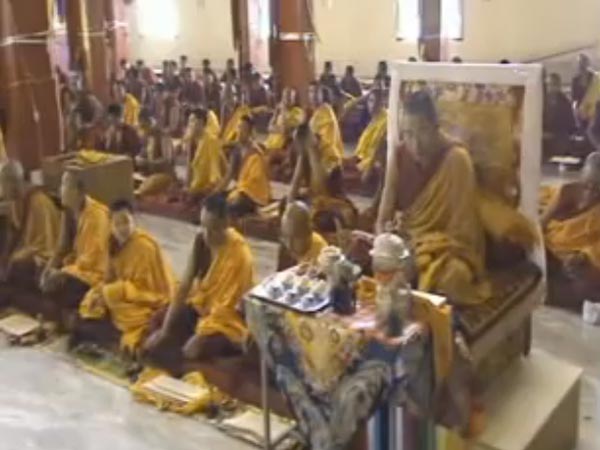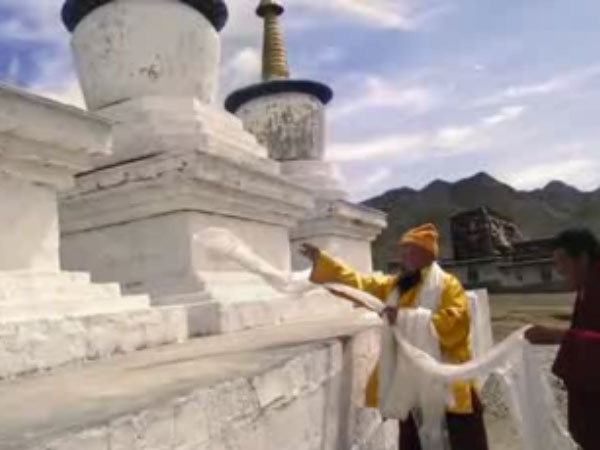DHARMA READINGS
| WHY MANJUSHRI MATTERS | | Print | |
 The Origins of ManjushriThe lineage of Manjushri can be traced back to the time of Buddha Shakyamuni who, in the sacred text of the Avatamsaka Sutra, mentioned that Manjushri’s actual identity is the Buddha Nageshvaraja who achieved enlightenment many eons ago in a different world system. Readers' Comments
Of the eight great Bodhisattvas – the close sons of Buddha Shakyamuni, Manjushri is revered as the most senior; the foremost Bodhisattva who embodies the perfection of Wisdom in the Buddhist pantheon. Reading through the scriptures, one will note multiple instances where Manjushri initiates many teachings just by asking a question of Buddha Shakyamuni. Within the Gelug refuge tree, Manjushri stands as the main lineage master of both the Kadam and Gelug schools, beginning with the Buddha Vajradhara himself and continuing in an unbroken line of enlightened masters – a pure source of unadulterated dharma, undeviating from the Buddha’s teachings. Within the merit field, Manjushri also appears as the leader of the lineage of Pervasive View, the patriarch of Arya Nagarjuna who founded the Middle Way and the Mahayana school of Buddhism. The word “Pervasive” means that this view is free from extremes and is unbiased; it is objectively based on benefit and takes no sides. “View” refers to the correct view of all phenomenon and the Dharma. This school of thought emphasizes the methods of memorization, understanding, debate and contemplation to realize in depth the meaning of the Buddha’s words of wisdom. Within Tantra, Manjushri is a lineage master of many tantric texts and lineages, predominantly those of the father tantras such as Guhyasamaja. For instance, Manjushri takes on the form of Yamantaka who is the Opponent of the Lord of Death, and whose tantric system focuses on transforming one’s gross and subtle consciousness into qualities of enlightenment. The Yamantaka Tantra is the only tantra that promises salvation within a single lifetime for those who have committed the five heinous crimes: drawing blood from a Buddha, killing an Arhat, killing one’s mother or father, and creating schism within the Sangha community. Just like the process of turning dirt into diamonds, the practice is arduous and even dangerous, but promises to grant enlightenment within the shortest possible period of time based on one’s karmic dispositions. As we enter the last few hundred years of the reign of Buddha Shakyamuni’s teachings, Yamantaka’s blessings continue to remain potent, thus allowing sentient beings to purify their misdeeds and gain the necessary attainments to achieve enlightenment through his practice. Such is the power and blessings of Manjushri in this day and time.
The Father of All Buddhas
Mahasiddha Geshe Tsultrim Gyaltsen In many stainless tantric texts, Manjushri is praised as the Father of All Buddhas. This does not mean that Manjushri is the biological father of all Buddhas; rather, it means that the wisdom energy that he embodies is necessary for one to achieve enlightenment. The Buddhas are considered to be the perfection of two collections – Merit and Wisdom, with Manjushri serving as the Father (Wisdom) component of enlightenment. Thus, it is clear that Manjushri is an essential part of one’s spiritual practice. The great Mahasiddha Geshe Tsultrim Gyaltsen of Ganden Monastery once expounded that:
Again, Manjushri above does not refer to the deity but to what he embodies: Wisdom. The realization of Wisdom arises from study, contemplation and practice. With time and consistency, knowledge, combined with intense contemplation and put into practice gives rise to realizations. The more we realize, the less ignorance there is in our minds. Hence, that is why there are ten levels of Bodhisattvahood: the more we realize, the less clouded we become and the greater our attainments.
How Understanding Relates to Manjushri The 21st century has blessed us with education and spoiled us with an array of convenient technology. With such convenience comes distraction from spiritual practice. As humanity looks further outwards for happiness and fulfillment, it becomes ever more unattainable. Why? Happiness, fulfillment, peace and harmony are inherently within us but are clouded by negative habits and past karmas from a different time. Convenience and the consequent distractions are the outer karmic formation of obstacles, while the inner karmic formation of obstacles arises through laziness, a desire for comfort, delusions, and wrong views. Modern education builds one’s IQ while developing one’s EQ and human sensitivities. There are many levels of education and each level enables us to learn and develop our character and personality with time. With this foundation, there is a possibility for us to tap into our spiritual selves and evolve from there. Thus, the very foundation of thinking, logic and reasoning correlates with what Manjushri represents. His practice is essential because by propitiating Manjushri on a daily basis, outwardly we are able to clear the obscurations within our mind, thus enabling us to see clearly who we are and where we are going. At a deeper level, his practice provides a source of inspiration, power and fuel for one’s spiritual journey. Having understood the concept of Manjushri, we shall now delve into the various aspects of Manjushri which we can tap into to achieve our highest potential.
Manjushri as Guru
Large Manjushri Thangka unveiled in Tibet Throughout time immemorial since the advent of Buddhism, Manjushri has manifested in many forms both celestial and mortal, animate and inanimate, to guide all sentient beings out of the cycle of transmigration. He has taken on the form of Bodhisattvas, Mahasiddhas and even ordinary beings, as if in a drama, to suit the propensities of each and every individual. In the Mahayana Tradition, an important aspect of Manjushri is that of the Guru, who guides the spiritual aspirant onto the path of practice and realization. Manjushri, in his various forms, has been the Guru of many prominent masters of ancient India and Tibet. He “saved” Bushuku or Shantideva from being jeered at by members of his entire monastery; he manifested to Je Tsongkapa throughout his life, giving guidance and direction; he even manifested as a poor lady with a child in Five Peaked Mountain (Wutaishan) to teach modesty and humility. The role of the Guru, regardless of whether the spiritual aspirant spends every waking moment with him, or just one teaching occasion, is a key factor in opening one’s seeds of enlightenment. With the sincere efforts of the spiritual aspirant, the Guru is able to guide and expedite the achievement enlightenment within a short span of time, as compared with that of a Sravaka. Within the snowy lands of Tibet, Manjushri has manifested three times to turn the Dharma wheel, first as the great teacher-yogi Longchenpa, a Nyingma master of both Sutra and Tantra. His major work, the Seven Treasures, contains 600 years of the Buddha’s teachings and he was a crucial link between the learning of Sutra and Tantra. Longchenpa established the Dzogchen teachings which are still widely practiced today within the Nyingma school. 
Sakya Pandita The second manifestation of Manjushri in Tibet was the great Sakya Pandita Kunga Gyaltsen. His coming was foretold by many great masters including Guru Rinpoche. At a young age, he spoke in Sanskrit and could recite the texts from memory without ever having laid eyes on them. With due diligence, he reenacted the Vinaya, the code of conduct of Buddhism and widely preserved and proliferated the Sutric and Tantric teachings. Sakya Pandita was the father figure of the Sakya school and the teachings of Lamdre originated from him. The third turning of the Wheel of Dharma in Tibet by Manjushri was through Je Tsongkapa Lobsang Drakpa himself. Born amidst auspicious omens, Lama Tsongkapa dedicated his entire life to the preservation of the Dharma, especially the Vinaya, Sutras and Tantras, during a time when the Dharma had degenerated in Tibet. His views and cohesiveness in the Dharma silenced a nation of false orators and reestablished the Banner of Victory in Tibet. His deeds spread far and wide, to China, Turkestan, Mongolia and even to the Land of the Aryas – India. Subsequently, Ganden, Drepung and Sera monasteries became the beacon of light and hope for those who wished to study and contemplate on the teachings of Buddha Shakyamuni. Je Tsongkapa further united the Tibetan nation with the Grand Prayer festival (Monlam Chenmo) by making vast offerings to the Buddhas at Jokhang Temple day and night during the month of Miracles. Such was his fame and glory and through his works, the essence of Dharma is preserved until today. Evidently, the manifestations of Guru Manjushri are innumerable, as Manjushri further emanates as disciples, geshes, humble monks and yogis in order to undertake the tasks of a Guru. But to cite the three main figures to invoke one’s faith is as necessary as feeding oneself to avoid starvation. If we have pure view and faith in the Buddha Dharma, it is not difficult for us to see the outer Guru Manjushri, whose work invokes the inner Guru Manjushri, so that we can realize the Secret nature of Manjushri which is total enlightenment.
Manjushri the YidamFrom the assembly of meditational deities who exist to tame and set our minds on the path of fruition, Manjushri also appears in different forms and aspects according to the time, people and dispositions. He manifests as a Yidam in all four classes of Tantras to suit the needs of practitioners. In the Kriya Tantras, Manjushri appears at the entry level to overcome difficulties for the practitioner in order to set their minds on the path of spiritual practice. These manifestations arise in different forms, each enacting different activities ranging from destroying terminal diseases, plagues and sicknesses to overcoming mundane problems of poverty, unhealthy relationships and more. The list goes on. With the practitioner’s problems on their way to resolution, the next class of tantra, the Charya Tantras, kicks into play. Here, Manjushri creates conducive conditions for spiritual growth, bringing resources and clearing obstructive factors in order for us to ground ourselves in Buddhist study and practice. In the intermediate and advanced levels, practitioners develop the views and realizations of Renunciation and the Bodhi Mind with Manjushri’s assistance. The third class of tantra is the Yoga tantras, which prepares the practitioner’s body and mind for the Highest Anuttara Yoga Tantra teachings. Manjushri manifests as the ferocious Yamantaka, complete with many hands carrying various weapons and legs trampling on different forms of opposing forces. At this point, the practitioner’s devotion to the Guru has to be firm like a rock, and his understanding of the Lamrim has to be deep in order to engage in this sacred practice, which propels the practitioner towards enlightenment in the swiftest manner possible.
Manjushri the Protector
Dorje Shugden statue in Trode Khangsar As with all things in life, we need security, assurance and a guiding hand to help us move in the right direction. Dharma protectors in general protect the Buddha Dharma from all forms of destruction; they protect the Gurus and lineage masters as they are holders of the Dharma; they protect monasteries, nunneries and all forms of Dharma institutions as they are seats where the Dharma will flourish; they protect practitioners of the Dharma because all of us have the potential to gain Dharma realizations. Dharma protectors guard the practitioner’s three doors – body, speech and mind – so that we may avoid transgressions which will slow down our progress towards enlightenment. Once again, Manjushri manifests as different dharma protectors to guard different aspects of the Dharma. For instance, Four-Faced Mahakala guards the Heruka tantras, while Dharmaraja Kalarupa guards the Lower Scope of the Lamrim as well as the Yamantaka Tantras. Manjushri in the form of Dorje Shugden manifests as a Dharma protector of Je Tsongkapa’s teachings, to preserve the lineage and the practitioners who have entered into the teachings of the Second Buddha Je Tsongkapa, who is also none other than Manjushri. As Dorje Shugden, Manjushri uses skillful means to guide sentient beings to enlightenment. The four emanations of Manjushri Dorje Shugden bestow activities of pacification, increase, control and wrath to bless sentient beings with animate and inanimate resources, thus fulfilling their secular and spiritual needs. In doing so, as more and more people are set on the path of realization, the Dharma grows in terms of study, contemplation and practice. From Manjushri, we realize the need for compassion. From Manjushri, we realize the need for skillful means and protection. From Manjushri, we realize and achieve wisdom. Hence, Manjushri is most relevant and prevalent in spiritual practices for the people of today. This does not mean the other Buddhas and Bodhisattvas are not useful but rather the time and disposition of beings today need Manjushri more.
|
OTHER DHARMA READINGS
- A GUIDE TO SPIRITUAL PRACTICE
- DHARMA DEMYSTIFIED: NAGARJUNA, THE FOUNDER OF THE MAHAYANA TRADITION
- DORJE SHUGDEN ON BLACK HORSE
- WHY MANJUSHRI MATTERS
- DHARMA DEMYSTIFIED: THE ENTHRONEMENT OF DORJE SHUGDEN









